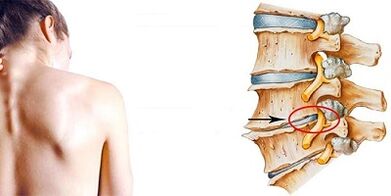Crusts, fluctuations in pressure, fainting, heart pain: all this often happens from problems with the spine.80% of the population suffers from osteochondrosis of the cervical region of variable gravity and, according to statistics, men face it before women: at 45-50 years.If treatment does not begin at an early stage, the pathology becomes irreversible.
What is osteochondrosis?
The pathology is associated with distributing changes in the cartilage between the vertebrae, in which the soft tissue becomes hard and the depreciation falls.
Osteochondrosis affects the thoracic region, lumbar, but more frequently the rest, the cervical.The reason is in high loads in 1-7 vertebrae, weak muscles, poor nutrition and choose an incorrect sleep pillow.
The mechanism of damage to the vertebrae of the cervical region

Osteochondrosis develops when the cartilage nutrition process, mineral metabolism is altered.The strength of the bones and the joints fall, the ligaments lose their elasticity.The form and structure of the disc are changing, under the influence of the loads it is destroyed.The vertebrae bind, their surfaces are erased.Pathology causes such complications:
- The closure of the blood vessels that pass through 1-7 vertebrae cause hypoxia (oxygen starring) of the brain.
- The development of problems in the work of the respiratory system, the blood vessels, the heart, the fall of the vision.
- The violation of the blood circulation of the brain leads to neurocirculatory (vegetative-vascular) dyston.
- Reducing neck mobility, by forming bone formations in vertebrae.
- The violation of the function of the cerebellum, squeezing the spinal cord, leads to death with an advanced stage of the disease.
Stages of Cervical Osteochondrosis
The pathology develops slowly.In the preclinical stage, the distance between the vertebrae decreases, press on a soft disc.Then it becomes thinner, the fibrous ring is destroyed, its nucleus is beating.The bump is formed, then a hernia.The vertebrae with each other, change the form, the growths appear in them.The nerves, the blood vessels are pinched.
The initial stage of osteochondrosis of the cervical region
The cracks appear in the fibrous ring, the capsule breaks, the jacket is damaged.Cervical osteochondrosis is felt when the head revolves, when nerve endings are pinched, the vessels narrow and the bloodstream suffers.There are pains on the back of the head, the back muscles quickly get tired.
2 stages of pathology
The degenerative process is developed on the discs, the capsule ring is completely destroyed.The height between the vertebrae is reduced, they become unstable and the nerve roots of the spinal cord.The flexibility and mobility of the neck fall.At this stage, the disease is still without surgery.
The latest stages of neck osteochondrosis

In the third stage of the pathology, the protuberance of the album develops, which leads to a hernia, the octopoe ring stands out and Burtles.Cervical vertebrae and their axis change, brain nutrition suffers.In addition, the following processes begin in the last (3 and 4) Pathology stages:
- Intervertebral discs are destroyed, which replaces connective tissue;
- The mobility of the cervical and shoulder joints disappears;
- From friction on the surface of the vertebrae, growth is formed, nerve fibers are injured;
- The sensitivity of the hands falls due to problems with its innervation.
Symptoms of osteochondrosis of the cervical column
The patient's condition depends on the disease stage.First, rare pain appear when turning or lowering the head, the tension of the back muscles.After a person experiences constant fatigue.The pain becomes stronger and more often.In addition, weakness, dizziness, rings in the ears are added, visual acuity falls.All signs of osteochondrosis of the cervical column are divided into 3 groups:
- Irritive reflex syndromes-Neurodistfic, vegetative and vegetative manifestations.
- Brown compression- They are associated with the compression of nerve endings, one of the key symptoms is acute pain when turning their heads.
- Vail artery syndrome- It occurs by reducing the glass that feeds the structure of the brain.
Neurotic disorders
The brain supplies bad blood, its work and the state of the nervous system is disturbed.Often, the head hurts, insomnia torments, which causes a state of fatigue, apathy.After the symptoms arise:

- greater sweating;
- Emotional lability (mood instability);
- greater irritability;
- dizziness;
- depression;
- violation of the concentration of attention;
- noise in the ears;
- "Full" in the eyes;
- anxiety;
- tremor (tremor) of the limbs;
- panic attacks;
- Vestibular apparatus disorders: nausea, vomiting, gear instability, disorientation in space, deteriorated coordination.
General clinical signs
The osteochondrosis of the cervical vertebrae causes headaches, visual deterioration.In 2 stages of pathology, patients complain about a sound in their ears, a bulge bulge, weakness of the muscles of the hands, numbness of the tongue.When turning the neck and inclination of the head, a crunch is heard, black points appear in front of the eyes.With vertebral artery syndrome, other symptoms appear:
- migraine that goes from the back of the head to the forehead;
- darkening before the eyes;
- Scalp pain;
- hearing loss;
- increased blood pressure;
- The tingling of the fingers.
Cervical osteochondrosis symptoms in women
The clinical image does not depend on the floor, but women from 45 to 65 years often experience numbness of the limbs in a dream, tingling and pain in their hands.The attacks are repeated at night several times.
Causes of cervical osteochondrosis
The pathology develops under the influence of a high load on vertebrae, which causes muscle spasm.Often, the sitting work leads to this, on the computer, in the vehicle.
At risk are people with posture disorders.Other causes of cervical osteochondrosis:
- nerve tension, frequent stressful situations;
- Hypodinamia: lack of physical effort, low activity;
- neck weakness;
- hereditary predisposition;
- column injuries;
- rheumatism;
- Excessive physical activity, weightlifting;
- incorrect nutrition;
- metabolic disorders;
- frequent hypothermia;
- Age -related changes in the musculoskeletal system, cartilage fabric;
- congenital anomalies in the development of the cervical region;
- autoimmune pathologies that affect cartilage tissue;
- overweight;
- The instability of the vertebrae.

Diagnosis
The doctor studies the patient's complaints, evaluates posture, muscle tension.Clarify the diagnosis using a neck radiography in 4 projections: The image shows the position of the vertebrae, displacement.The stage of the disease and hidden pathologies are revealed through the following methods:
- Magnetic resonance tomography- The most productive method shows in detail the degenerative changes in the bones, the hernias, the protuberance, the ruptures of the fibrous ring.It can be prescribed instead of the radiography, but the exam is expensive.
- Duplex scan of ultrasound- Evaluate blood flow disorders in the arteries.
- Computed tomography- It does not reveal the size and area of hernias, it is prescribed in the early stages to determine the narrowing of the vertebral gap, the displacement of the segments of the cervical column, the edge of bone growth.
Cervical osteochondrosis treatment
The objectives of the therapy are to restore blood flow, tissue nutrition, eliminate hypoxia symptoms, stop the destruction of vertebrae and discs.It is important to strengthen the muscle corset that supports the neck, to return mobility to the joints.Tactics of treatment are chosen at the disease stage:
- Initial- Massage, gymnastics, physiotherapy, taking condoproprotectors and drugs that improve blood circulation.
- Osteochondrosis 2-3 stages- Medical treatment, therapeutic exercises, massage.
- Irreversible degenerative changes with the destruction, deformation of the vertebrae- Surgical intervention and symptomatic therapy with medications.
- Exacerbation of the chronic form of cervical osteochondrosis- Injections or drug tablets that relieve pain, spasms.
Help in pronounced pain
Locally in the neck they influence the pepper patch or heating ointments.The active heating of a separate site distracts from pain, improves blood flow in tissues.The ointments apply with a very thin layer using an applicator.Other ways to eliminate pain in osteochondrosis:
- Analgesics in tablets- They have an average effectiveness, contraindicated in problems with blood clotting.
- Non -steroid anti -inflammatory drugs- Tablets are taken in the absence of a result of analgesics, since this drug group negatively affects the stomach and liver.
- Injections- I put intense acute pain, the action is manifested after 15 minutes.For intramuscular injections, NVP is used, myotropic antispasmodics are used.In severe cases, they make a blockade.
Conservative Methods of therapy for Neck Osteochondrosis
At 1-2 stages of the disease without symptoms of cerebral hypoxia, the treatment is carried out at home.The basis of therapy is gymnastics and massage.They improve blood flow, strengthen the muscles.Other methods:
- Drug therapy- Oral administration of drugs and injections for exacerbation, ointments and creams the rest of the time.
- Physiotherapy-Counces of 7-10 procedures during remission.
- Popular remedies- As an additional method of treatment of osteochondrosis.
- Diet therapy- Products rich in fatty acids, magnesium, calcium are introduced into the diet.Exclude salt, smoked meats, pickled foods and spicy, fast food.
Medicine
The treatment for cervical osteochondrosis during exacerbation aims to relieve unpleasant symptoms, blood flow stimulation, tissue nutrition.
During the remission period, medications are used that improve cartilage quality and avoid the vertebrae of the collapses.The medications are used internally and locally.The main groups of funds are:
- Musorelaxantes- Relieve muscle spasm, reduce pain, are used for a month.
- Non -steroidal anti -inflammatory drugs (NSAIDs)- They are used locally and inside, relieve pain, swelling.Tablets are used no more than 10 days.
- Analgesics- Anesthesia, but we do not eliminate inflammation and, in terms of effect, we are weaker than the NSAIDs.
- Condroprotectors- Protect and restore cartilage.
- Sedatives- They are often prescribed for women in which the osteochondrosis of the cervical column is complicated by severe neurotic disorders.
- NOOTROPIC- They act on brain circulation, help fight dizziness.
- Vitamin and mineral complexes- Improve metabolism in nerve tissue.
Without a flutist
During the remission, the treatment of neck osteochondrosis is based on local procedures that improve blood flow, metabolism, relieve pain, inflammation.The patient is dedicated to gymnastics every day, whose plan prepares a doctor.The main treatment methods are as follows:
- Manual therapy- straighten the position of the vertebrae and their consolidation with massage.The 5-10 sessions course passes 2-4 times a year.At home, a light massage is allowed with caressing and rubbing the cervical area and the necklace from top to bottom for 7-10 minutes to relieve muscle spasm.
- Drug electrophoresis- Preparations for pain relief and the improvement of blood circulation are used, which with the fastest current fall at the desired point.
- Magnetotherapy- Aimed at eliminating edema.
- Acupuncture- Improve blood flow, it relieves inflammation.It takes place in courses in 8-10 sessions after 1-2 days.
- SHANZA COLLAR- The controversial method to eliminate the symptoms of osteochondrosis, since the load in the muscles is eliminated, but they are not strengthened.The product fixes the neck and extends the column, increasing the distance between its segments.They wear a necklace for 3 hours a day for a month.
Exercise therapy for osteochondrosis of cervical vertebrae
Out of exacerbation periods, it is shown that the patient performs therapeutic exercises.Strong head inclinations are prohibited forward and backward, rotation.Each exercise is done more than a minute, without sudden movements, idiots.If discomfort or pain occurs, the lesson stops.Proven exercises for the cervical column:
- Slowly turn your head to the right and left, looking at the point in front of you: to control the small amplitude of the movement.Make 10-15 times in each direction, gradually bring 30.
- Put the palm of the palm on the forehead and press, while trying to bow your head forward.Read 5 and relax.Repeat 10 times.
- Cover the left temple with the right palm, press to bow your head towards the shoulder.Read 5, let it go.Make each side 10 times.
- Lying on the stomach, stretch your arms along the body.Lifting your head slightly, swallow it slowly to touch the floor with your ear.Make 10 movements on each side.
Surgical methods for the treatment of osteochondrosis of the cervical region
If the nerve roots are affected, there is a hernia with a break of the ring, the vertebrae are destroyed and there is no result of the main therapy, and the operation is performed.
Symptoms of a severe state: hands paralysis, muscle atrophy, stroke.The main treatment methods:
- Fassetectomy- Endoscopic elimination of the joints with the subsequent fixation of the vertebrae, which will be motionless.
- Dissectomy with spondilode- It is prescribed for serious deformation changes.During the operation, a soft disc is removed, the vertebrae are spent to stop their destruction.Cons: The mobility of the cervical region is a long and limited rehabilitation.
- Spinal Fusia- Elimination of fragments of a destroyed disc, bone processes, the introduction of an artificial transplant and the fixation of the vertebrae.The recovery period is a year, the patient is indicated by the use of a corset.
- Correctomy- Eliminate the destroyed vertebra and the nearby discs are carried out in the absence of the effect of other methods.
Popular remedies for cervical osteochondrosis
With severe pain, take 1 teaspoon.Alcohol and camphor, add 2 drops of iodine and rub the areas on the left and to the right of the column (do not touch the pillar itself) for 3-5 minutes.This is done 1-2 times a day.
Other popular recipes in addition to basic therapy:

- Pour 500 g of Knotweed with water (2 L), boil, insist.Pour the broth cooled through a gauze in a prepared bath, take it for 15-20 minutes.The procedure is carried out at night, relaxes and calm.The course is 7-10 sessions.
- Mix 1 tablespoon.l.Buds Buds, herbs of herbs from San Juan, mint leaves.Grind, pour a glass of water, boil for 5 minutes.Strain, mix with butter and vegetable oil (75 g each).Apply the ointment with a thin layer on the neck, cover with polyethylene and scarf at the top.Keep an hour.The procedures are carried out every day for 2 weeks.
- Pour 100 g of Saúco berries with vodka (600 ml).Insist a week in a cold place.Rub the neck with this tool 2 times a day for 10-15 days.
Prevention
Patients over 40 should take calcium, phosphorus, vitamin D courses, magnesium every six months: they improve the condition of bones, ligaments and cartilage.The diet includes fatty fish, shrimp, mussels, nuts, legumes, spinach, cheeses, milk.Other preventive measures:
- In case of sitting work, change the position of the neck more frequently, love every hour;
- Choose a comfortable pillow;
- Swimming, yoga;
- Avoid heavy athletics, sports with jumps, running;
- Do not allow hypothermia.

























